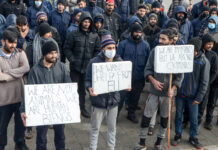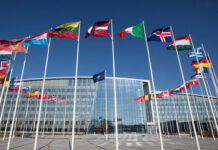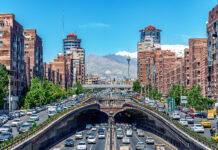China and India are the two most populous countries in the world and the two heavy weights of Asia. They are dynamic and fast-growing nations, even though the Chinese economy is far stronger than India’s. Both countries pursue power policies with global implications, even though China’s diplomatic and military weight is clearly superior to India’s. Finally, both countries have nuclear weapons. For decades, relations between the two Asian powers have oscillated between political-military competition, moments of conflict and (rarer) moments of cooperation. 2020 was dominated by conflict. The clashes had various levels of tension and sometimes involved other countries. The political overheating in the Pacific Ocean is another serious factor that, once again, involves several actors.
Tensions between Delhi and Beijing
While global attention focused on the threats exchanged between China on the one hand and Japan and the United States on the other in the South China Sea, tensions had also risen sharply in the western sector of the Himalayas, in the disputed border area between China and India. On June 15, 2020, a clash between border patrols resulted in the deaths of twenty Indian and four Chinese soldiers at Pangong Lake, in a barren valley about 4,200 meters high in north-eastern Ladakh. It was an almost white-collar battle, very low technology, even if conventional and atomic heavy weapons are always in the background. It was preceded and followed by repeated skirmishes, with both sides reinforcing the presence of troops in the disputed area. On 20 September, the foreign ministers of New Delhi and Beijing agreed on “five principles” to control tensions, including common military de-escalation. Since then, no other major clashes have been reported.
A year later, however, the troops had not been withdrawn. Pangong Lake and its surroundings, uninhabited and inhospitable, had been the scene of bloody fighting between India and China in 1962, during the war that ended with an Indian defeat that still today remains a trauma for the elite of that country. Although there was a diplomatic rapprochement afterwards, mutual suspicion has always remained between China and India. The territorial disputes between the two nations are a legacy of the 1962 war: the disputed border in Ladakh with Lake Pangong; the territorial dispute in the eastern sector, in Arunachal Pradesh (an Indian state of which China claims a part, defining it as Southern Tibet) and in Sikkim. Nuclear rearmament also stems from that defeat: China’s entry into the atomic powers (1964) convinced the Indian leaders to do the same (the first Indian atomic test was performed in 1974), also triggering Pakistan. In 1998 India and Pakistan carried out underground explosions that confirmed their possession of nuclear weapons.
China
Among the reasons for confrontation, India views with fear the strategic cooperation between China and Pakistan and the Chinese ambitions in the “neighbourhood”, from Nepal to Bangladesh to Myanmar. On the other hand, Beijing saw the nuclear cooperation treaty between India and the United States, which in 2005 effectively recognised India’s status as an atomic power, as an anti-Chinese manoeuvre. Beijing also sees the military manoeuvres in November 2020 by the Quad, the Quadrilateral Security Dialogue, a group that includes the US, Australia, Japan and India, as hostile. Then, there is the competition in the Indian Ocean. Over the past twenty years, China has built large ports in Gwadar (Pakistan), Hambantota (Sri Lanka), and Chittagong (Bangladesh).
Beijing denies their military significance, but India feels surrounded. It has therefore strengthened its naval presence in the Andaman and Nicobar Islands and in the Strait of Malacca, an important commercial shipping route between the Indian and Pacific Oceans. Finally, by deciding not to join the Regional Comprehensive Economic Partnership (RCEP), signed between Australia, Brunei, Cambodia, China, Indonesia, Japan, Laos, Malaysia, Myanmar, New Zealand, Philippines, Singapore, South Korea, Thailand and Vietnam in the November 2020, Delhi wanted to distance itself from an agreement considered too favourable to Beijing.
An Indo-Chinese war is not on the agenda. Successive leaders of the two countries share the belief that maintaining peace is essential for the development and prosperity of their respective nations and the region. Under the principles of “atomic deterrence”, New Delhi and Beijing have a nofirst-use nuclear weapon treaty. But theirs is a “cold peace”, accompanied by growing nationalist rhetoric. Meanwhile, troop movements continue on disputed borders and incidents like the one in June 2020 can always lead to unwanted escalations.
Kashmir, an endless conflict
The conflict in Kashmir, a territory in the extreme north-west of the Himalayan range, is one of the most prolonged regional crises in the Indian subcontinent and is a conflict both between states and within India. Between states, because the Kashmir valley, with a Muslim majority, is part of the Indian state of Jammu and Kashmir but is claimed by Pakistan. The two countries have fought three wars since 1947 for Kashmir. The first (1947-49) divided the state into one part under Indian sovereignty and the other controlled by Pakistan and the ceasefire line (“Line of Control”) has been the de facto border ever since. A new declared war (1965) and an undeclared one (1999) followed.
Since the early nineties, there has also been a sort of “proxy war” conducted by guerrillas infiltrated from the Pakistani sector into the Indian sector. Jammu and Kashmir are also the stage of internal political conflict. In 1989, a revolt for independence began that resulted in a creeping war fuelled by jihadists from Pakistan, often maneuvered by intelligence services from all sides. The Indian government responded by militarising the territory.
There have been tens of thousands of deaths, forced disappearances, extrajudicial executions, acts of violence and rape. Rare moments of easing of tensions and dialogue with the central government have been followed by new waves of repression. For years, emergency laws have been in place in the Kashmir giving the security forces special powers and impunity. In August 2019, the central government imposed unprecedented isolation in Kashmir even in this context of permanent conflict. Telephone lines and the internet were blocked, journalists’ work restricted, and entering or leaving the territory was prohibited. Meanwhile, massive reinforcements of troops had arrived and about two thousand journalists, parliamentarians, traders and intellectuals were arrested “preemptively”. It was the prelude to an institutional coup: on 5 August 2019, Indian Prime Minister Narendra Modi decreed the revocation of Articles 370 and 35A of the Indian Constitution, which granted the State of Jammu and Kashmir a broad autonomy of government.
The J&K has also ceased to be a “State” to become a “Union Territory” administered by the central government, while Ladakh (with a Buddhist majority) has become an administrative entity in and of itself. Some telephone lines were restored and some movements authorised only several months later. The internet was restored only in February 2021, after 550 days of total blockage. The territory remains militarised and the freedom of the press limited.
The repeal of Article 370 marks the ultimate humiliation of the only Indian state with a Muslim majority. It is not just a symbolic act, because the rule that prohibited non-Kashmiris from acquiring property in the state has also lapsed. Investors from other Indian states can now buy land, obtain mining concessions or start businesses in Kashmir. For most Kashmiris, it is the first step in dispossessing them and repopulating the potentially rich valley with non-Kashmiri Indians (and Hindus).
Disillusioned, many young Kashmiris will again opt for armed militancy. Meanwhile, clashes on the Line of Control are on the rise and a peace dialogue between India and Pakistan seems remote – especially after the two countries returned to the brink of conflict in 2019, when the terrorist group Jaish-e-Mohammed claimed responsibility for an attack on an Indian military convoy that killed over forty soldiers in February that year. A few days later, Indian Mirage 2000 fighters dropped bombs on a “terrorist camp” in a Pakistani-controlled territory of Kashmir. Islamabad captured an Indian aviator and then freed him, defusing more dangerous tensions between the two countries.
The rising tensions in the Pacific
The tone was anything but diplomatic. “Get out of the way,” Philippine Foreign Minister Teodoro Locsin wrote in Twitter in May 2021, addressing the Chinese and the presence of its fishing boats and ships in the exclusive economic zone of Manila. “GET THE F.CK OUT”, he intimated to Beijing (including capital letters), accusing the Chinese of jeopardising the friendship between the two countries. In short, soft language is sometimes useless, according to the leader of Philippine foreign policy, not new to outbursts of this kind. This time, the message had to be made directly, after the accusation against the Chinese coast guard of threats against Filipino ships in the waters around the Scarborough shoal (also called Bajo de Masinloc in Spanish or Panatag Shoal or Huangyan Island), two reefs of an atoll between the Macclesfield and Luzon reef in the South China Sea. But the outburst has deeper origins. At least since the end of March, about 200 Chinese boats have been stationed near Whitsun Reef, a coral reef part of the Spratly Islands that Filipinos consider under their sovereignty. These are ships of the so-called maritime militia. As Carl Schuster, of Hawaii Pacific University explains to the Indian magazine Outlook, it is formally fishermen and workers who preside over the Chinese coasts. Since the 1960s, their business has gradually expanded into the East and South China Sea. In practice, these are paramilitary forces whose presence helps Beijing claim almost the entire portion of the waters disputed with Malaysia, Vietnam, Taiwan, Brunei and Indonesia.
For China, maritime claims are an issue that is virtually impossible to discuss with neighbouring states. And when this happens, China ensures that its approach is bilateral and not multilateral to leverage its economic weight. Alessandro Uras, PhD in History and Institutions of Asia and Africa and expert on the subject at the University of Cagliari explains it well on Sinosfere: the disputed stretches of sea are considered “sacred territorial waters” belonging to China since time immemorial. The Chinese claim it is based on historical legacy rather than on legal grounds. There are also geopolitical and economic reasons for this. The area is one of the richest seas in the world in terms of flora and fauna and the presence of important fish and natural resources, gas, oil and rubber is of vital importance for the coastal states.
Over the years, the Chinese have therefore militarised atolls and sandy banks, built artificial islands, including the South China Sea within their national borders, creating, for example, the district of Nansha, which includes the Paracel Islands, or that of Xisha, which includes Spratly and the Macclesfield Bank. Warships and coastguard ships operate regularly in the disputed stretches of water, along with maritime militias, entities that are now also used by others.
Similar structures have been adopted for example by Vietnam. According to the National Institute for South China Sea Studies, an organisation based in the Chinese province of Hainan, in the last 12 years, the Vietnamese paramilitary forces has doubled its personnel, increased to about 70 thousand units. Tensions in the area are also part of the delicate balance between governments. The Philippines, under the presidency of Rodrigo Duterte, approached its Chinese neighbour, which also provided vaccines in the midst of the Covid-19 pandemic, and stepped into a difficult relationship with the United States, a colonial power in the archipelago and stone guest in the area. Manila sees Beijing as an indispensable commercial partner. Nonetheless, the Head of State had to take a firm position on the maritime question, reiterating that sovereignty over the contested waters “is not negotiable”, while warning his ministers not to indulge in comments on relations with China.
In this context, China has not hesitated to up the ante. This has been demonstrated by the Malaysian decision, in early June, to summon the Chinese ambassador after the intrusion of sixteen military aircraft into the Kingdom’s skies, about 60 nautical miles from the state of Sarawak. An episode considered by the Kuala Lumpur government as a “serious violation of national sovereignty and in-flight safety”.
The Taiwan Strait
However, attention in the area is focused in particular on the Taiwan Strait. The island has been described as the most dangerous place on the face of the Earth, at least at this time. Relations between Beijing and Taipei had not been so strained since at least the mid-1990s, when the People’s Republic responded with missile exercises to the US’ visit to then President Lee Teng-hui. In the last year, the incursions of spy planes and military jets have increased in the so-called “aerial identification zone” of Taiwan, where the Progressive Democratic Party of Tsai Ing-wen has been in power since 2016 and has positions of greater autonomy than China, with which since 2008 the previous administration of Kuomintang nationalists had embarked on a process of rapprochement, especially an economic one.
Taiwan has actually been independent since 1949, when the Communists took power in Beijing. The nationalists then formed their own government on the island, which now looks with apprehension at the forced normalisation that has taken place in Hong Kong over the past two years. Reunification with mainland China is one of the cornerstones of the so-called “Chinese dream” outlined in 2013 by President Xi Jinping, changing the idea from the American dream. In a nutshell, it is the belief that China should no longer suffer the shame and humiliation of the late nineteenth and first half of the twentieth century at the hands of Western powers and Japan, divided between warlords and involved in a civil conflict. Xi therefore speaks of the nation’s rebirth. And in this context, the return of Taiwan can no longer wait “from generation to generation”.
If until some time ago the prospect of adopting the “one country, two systems” principle also in Taiwan after Hong Kong could be indicated as a solution to reunite Taipei and Communist China, the tightening imposed by the Beijing government on the financial hub has made this road impracticable in the eyes of Taiwanese.
The question remains as to whether the United States is ready to embark on an eventual open conflict with China should the situation deteriorate and the Chinese leadership should attempt a forceful action to restore the island. In March, Joe Biden’s administration approved the sale to Taiwan of key technology components for the construction of its new submarines. Former President Donald Trump had previously authorised $ 1.8 billion in sensors, cruise missiles and artillery pieces destined for the island, and American warships continually cross those seas. However, recent press rumours have reported on the US President’s intention to avoid a direct confrontation between the two superpowers. A war in the short term is, in any case, judged unlikely. It is therefore more likely that Washington, depending on what emerges, will continue with the supply strategy to strengthen the Taiwanese defence and will be able to opt for the use of sanctions in the event of a worsening situation on the ground.
Certainly, citizens on the island are increasingly more sceptical towards Beijing, so much so that 67% of the population, according to a survey by the National Chengci University, identifies themselves exclusively as Taiwanese, as IPSI states. Decades of independence have de facto marked a divide, particularly among the younger generations. Furthermore, as already mentioned, the repression against the democratic movement in Hong Kong and the narrowing of the territorial autonomy spaces weighs heavily.
The Hong Kong knot
On March 27, 2021, the go-ahead from the Legislative Council (the Hong Kong mini-parliamentarian) for Beijing’s controversial electoral reform is only the latest intervention to align the Special Autonomous Region with mainland China. In addition to giving the central government the right to veto candidates, the new system restricts the number of elected councillors, despite the fact that overall, the legislators increase from 70 to 90. Of these, 40 will be appointed by a government 46 Parallelo 1 6 1 Atlas of Wars and Conflicts in the World commission, another 30 selected by the so-called ” functional colleges”, that is, business representatives.
The commitment to guarantee universal suffrage is therefore removed. Since the national security law was passed on the eve of July 1, 2020, in response to a year of demonstrations sparked by the proposal for new extradition rules, the former British colony is in a very disadvantaged position. Beijing used a very broad definition of national security, as Amnesty International points out, allowing the provision to be used to interfere with both information and education. Slogans like “Free Hong Kong” have been declared subversive and the “Glory to Hong Kong” anthem banned from schools. Indeed, the Education Department has drawn up guidelines to establish that from the age of six, children must learn what is considered subversion and what is considered collusion with foreign forces. “The right to freedom of peaceful assembly has been further reduced by the seemingly arbitrary application of the rules of physical distancing, in the context of the Covid-19 pandemic,” notes Amnesty International. The fear among the population is that the territory will simply become a Chinese city like any other, while prominent opposition figures are silenced and jailed. The sentencing of entrepreneur Jimmy Lai, editor of the Apple Daily, one of the most tenacious opposition newspapers, accused of having organised a large march on August 18, 2019 is very symbolic; as are the arrests of politicians and activists for organising informal primaries for the opposition to select its candidates in the Legislative Council elections. However, the financial hub continues to play a key role in attracting foreign investments.
Meanwhile, the former British colony has become the chosen landing place for the Dragon Big Tech for secondary quotations. At the end of March, Baidu, the Chinese leader of search engines already listed on the Nasdaq, raised nearly $ 3.1 billion through the secondary listing. Since the Asian market loosened its rules in 2018, according to estimates by the research firm Dealogic, a dozen Chinese listed companies in the US, including Alibaba, NetEase, YumChina, Jd.com, have raised about $30 billion in Hong Kong. The list is destined to grow since the SEC, the US market supervisory authority, has put a spotlight on the Dragon’s listed companies, with the threat of deleting them from the list if they do not comply with US auditing standards. In this context, Beijing is still trying to incorporate Hong Kong into the Great Bay area. This also includes Macao and the rich province of Guangdong, where megacities such as Shenzhen which, through dedicated laws to increase their competitiveness, can deprive the financial centre of the characteristics that make it attractive for investors, even if the central government plans for “the fragrant port” to become the main hub for asset management companies. The repression in Hong Kong also affects Taiwan at a time when Taipei officials have been faced with the choice between not having their visas renewed or claiming to support Beijing’s claims to the island under the One China policy.
The Xinjiang issue
Chinese leaders retaliate against international protests by denouncing interference in internal affairs in the People’s Republic. This level of rhetoric has risen, as demonstrated by the sanctions imposed by the People’s Republic against the Euro-parliamentarians MEPs Reinhard Butikofer, Michael Gahler, Rapha l Glucksmann, Ilhan Kyuchyuk and Miriam Lexmann, and against other European scholars and entities in retaliation against the restrictive measures decided by the EU Foreign Affairs Council against Xinjiang Autonomous Region officials held responsible for the large-scale arbitrary detentions and abuses suffered by the Uyghur minority.
Since 2017, it is estimated that at least one million Uighurs (mainly), Kazakhs and Uzbeks have been arbitrarily detained. Some estimates are closer to 1.5 million. For the Chinese leadership, these are professional reintegration programmes, a way of contrasting radicalism and the so-called “three evils” pointed out by China as the main risks for the country: separatism, extremism and terrorism.
The Xinjiang region, located in the far west of the People’s Republic and a strategic land gateway to the Belt and Road Initiative (the large infrastructural and commercial connection project with Europe), is also becoming a test bed for testing surveillance and identification technologies. The country is accused of demographic and cultural “genocide”, a definition espoused by some governments and parliaments, such as Canada, and criticised by others because in the international arena, the perpetration of genocide is more difficult to prove than the systematic violation of human rights.
From the Chinese side, the justification is the need to support the territory on its way towards progress. Reports on economic progress have therefore increased. According to official data, the average annual income in urban areas has grown at an average annual rate of 6% over the past 5 years and reached $5,400 last year, while in the countryside it is a third of this. Instead, at least 3 million farmers have emerged from poverty in recent years. This is the position of Beijing, which calls the accusations of internment of the population and exploitation of forced labour slander.
To counter this narrative, the Chinese communication machine has become more assertive. This has often been described as Wolf Warrior diplomacy, which gets it name, from the title of a series of films similiar Rambo but starring a former Chinese soldier. The idea is to retort point by point, propagating the image of China as a responsible actor on the international chessboard while claiming the efficiency of its model, comparing it to the difficulties encountered in recent years by liberal democracies both on the political level (with the emergence of sovereign forces) and with economic and pandemic management. The Xinjiang case, however, demonstrates China’s difficulty in managing the borders inhabited by ethnic minorities. This is also happening in Inner Mongolia, where at the end of 2020 there were tensions and protests against the imposition of a more widespread use of putonghua (the official Mandarin language), to the detriment of Mongolian, in an attempt to strengthen national identity.
Tibet dossier
Similar attempts are still underway in Tibet. Seventy years after the signing of the 17-point treaty that sanctioned the “peaceful liberation” of the region, where Chinese troops had entered the previous year, Beijing has no intention of loosening its grip. On the contrary, the intention is to support and strengthen the presence of the Communist Party. Only in this way the Chinese leadership believes that Tibet will be able to “continue its development path”. The facts “show that Tibetan independence is nothing but the product of imperialist aggression against China,” reiterated the secretary of the CCP in the region, Wu Yingjie. And he added that “driving the imperialists out of Tibet was a precondition for the Chinese people to preserve national unity”. International attention is focussed once again on the Tibetan cause. In December 2020, the US Congress passed a law supporting the right of Tibetans to independently choose the future Dalai Lama, the spiritual guide of Tibetan Buddhism. For the People’s Republic, this is yet another intrusion into internal affairs. In the latest white paper on Tibet, the Communist government reiterated that the area has been part of China for centuries and as such has been inalienable since ancient times, tracing the domination back to the seventeenth century.
In the style of the People’s Republic, the document rattles off on what it claims are the results obtained. The average per capita income for rural residents reached 14,598 yuan (about $2,271) in 2020 and is up 12.7% year by year, while that of urban residents reached 41,156 yuan (+ 10%). “Tibetan Buddhism has always been part of Chinese culture”, is the concept underlined by Wu, in a sinisation of the religious aspect, exploiting it to exercise control. Once again, Beijing focuses on the numbers in the white paper that indicates what the Chinese want to focus attention on. For example, it takes pride in the ninety-two living Buddhas identified and approved through traditional religious rituals and historical conventions. In the background is the designation of the next Dalai Lama, the fifteenth. Tenzin Gyatso, in exile in India since 1959, is 86 years old and although his health conditions are still considered good, the debate on what will happen after his death is open and has become a geopolitical issue, with China on the one hand and the United States and India on the other.
According to a Bloomberg agency report, New Delhi government officials have already begun to hold talks to understand how the Indians will influence the choice, also considering that the Federation hosts the Tibetan government in exile in Dharamsala. There is talk of assemblies between monks of different sects, with the aim of guaranteeing the legitimacy of the succession and covering the power vacuum pending the identification of the child considered the reincarnation of the Dalai Lama.
The US has also entered the conversation. “We believe that the Chinese government should not have a say in the succession,” reiterated last March the US State Department spokesman, Ned Price. From this point of view, Joe Biden’s administration does not seem to have opted for a softer attitude than the previous US administration, led by Donald Trump. Also quoted by Bloomberg, Samdhong Rinpoche, a member of the Dalai Lama’s office, recalled that if Tibet continues to remain occupied, then “His Holiness could be reincarnated elsewhere, probably in India”. At this point the Chinese, as already done in the 1980s by replacing the chosen Panchen Lama with a child of their choice, could appoint a successor of their own. Beijing again appeals to what is reported in the White Paper, in which the Qing-era edict of the Qianlong emperor is recalled, to make the draw for the so-called “golden urn” the only correct method to select between the candidates approved by the authorities as successors of both the Dalai Lama and the Panchen Lama. The reply to this claim is that this system has only been used for two of the fourteen Dalai Lamas indicated so far.
The issue is not easily resolved. Meanwhile, Beijing is trying to extend the boundaries of what it considers historical Tibet under its sovereignty. To account for this, Robert Barnett, an expert on Tibet and Buddhism, explains that Beijing is encouraging Tibetan shepherds to trespass into the nearby and small kingdom of Bhutan and build new villages to open the way for the arrival of workers and soldiers. This is the same strategy followed in the South China Sea, where China has occupied a series of tiny islands and created artificial ones as outposts. In this case, the occupation of the Beyul area, explains Barnett, would be a ploy to obtain territories in western Bhutan in exchange.


















